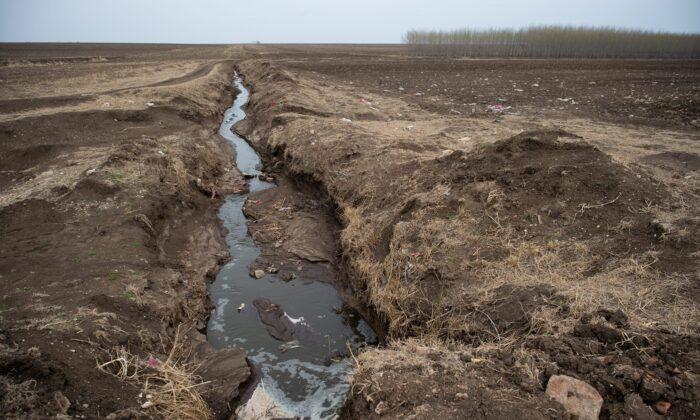China faces a food production crisis due to its agricultural policies that encouraged the over-pumping of groundwater and the degradation of soil in the pursuit of maximizing production.
From the completion of Chinese Communist Party leader Mao Zedong’s “Great Leap Forward” campaign of collectivizing China’s farms, in 1962, to China’s
First Nationwide Soil Pollution Survey in 2014, the country’s per capita renewable freshwater resources fell by 52 percent, from 4,225 cubic feet to 2,062 cubic feet,
according to a new report by Enodo Economics.
At least
45 million people died and agricultural output declined during the Great Leap Forward. But production rose after Mao’s death in 1976, mostly due to government-sponsored infrastructure that increased the use of groundwater and subsidies for agricultural chemicals.
China, with 9 percent of the world’s arable land and intensive farming practices despite an average farm size of 2.5 acres, has usually been able to feed its people—who now make up 19 percent of the world’s population—by tapping three major fossil water aquifers, and annually consuming more than 30 percent of the world’s fertilizer and pesticide supply, according to the report.
The most important aquifer lies in
North China, stretching across the Beijing Plain and extending east as far as Shanhaiguan on the Bohai Sea and south to Nanjing. It’s a key water resource for 13 percent of China’s agricultural production, 70 percent of its coal output, and 11 percent of its population.
But with urbanization tripling over the past 50 years, 400 of China’s 655 cities are also now reliant on groundwater. With fossil water rapidly running out, “more than 50 cities are experiencing land subsidence, including Beijing, Tianjin, and Shanghai. In some parts of the country, the land surface has sunk by more than 20 cm,” the report said.
The Chinese Academy of Sciences also
revealed in 2016 that 21 percent of arable land contained excessive heavy metal levels, with 5 percent classified as
heavily polluted. The study blamed government subsidies for nitrogen-based fertilizers that encouraged farmers to neglect soil conservation. But the resulting soil depletion now means that ever-greater volumes of nutrients are required to generate ever-lower agricultural returns.
Enodo Economics warns that the performance of the agricultural sector is a “key medium-term risk for the Chinese economy.” Just as the Middle Kingdom in the first two decades of this century generated a global demand shock that spiked metals and energy prices, “The next 10 years are set to witness a similar transformation in soft commodities.”
Unlike expanding metal and energy production that takes huge investments and time to build out the infrastructure, agriculture is of prime political importance to the Chinese regime. Metals and energy can be produced 24 hours a day and 365 days a year, but the agricultural supply peaks at harvest time, then relies on storage of food stocks.
The first Central Committee document issued at each annual plenary session includes agriculture. The plenary session is a closed-door meeting, with roughly 370 elite Chinese Communist Party (CCP) officials attending and discussing future personnel changes and policies. The
13th five-year plan issued in 2016 listed agriculture as the third-most-important state priority, behind only growth and innovation. The CCP promised its
South-North Water Transfer Project, the biggest and most expensive infrastructure project in the world, would divert enough water to supply China’s northern grain belt.
While Mao Zedong first discussed the project in 1952 as the answer to China’s water problems, Enodo Economics said, “China simply does not have enough freshwater resources to support existing let alone future levels of agricultural output.”
Corn prices in China typically averaged twice those in the United States, before trending down almost 40 percent as China reported it accumulated
61 percent of the planet’s corn reserves.
Enodo Economics believes the reported reserves don’t exist, because such long-term storage would be subject to substantial spoilage. Combined with groundwater shrinkage and pollution crises, Enodo Economics expects that Chinese food price inflation is set to rise dramatically.






Friends Read Free